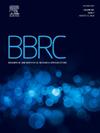Histone deacetylase inhibition disrupts the molecular signature of the glioblastoma secretome related to extracellular vesicle-associated proteins and targets RAB7a and RAB14 in vitro
IF 2.5
3区 生物学
Q3 BIOCHEMISTRY & MOLECULAR BIOLOGY
Biochemical and biophysical research communications
Pub Date : 2024-10-19
DOI:10.1016/j.bbrc.2024.150847
引用次数: 0
Abstract
Glioblastoma (GBM) is the most aggressive brain tumor with a poor prognosis. While Histone Deacetylase inhibitors have shown promising results in inhibiting cancer cell invasion and promoting apoptosis, their effects on GBM secretion, specifically focusing on extracellular vesicles (EVs) secretion, remain largely unexplored. Using label-free NANOLC-MS/MS methodology, we identified significant changes in the abundance of membrane traffic regulatory proteins in the secretome of U87MG cells after the treatment with the HDAC inhibitor Trichostatin A (TSA). In silico analysis showed that TSA treatment disrupted the secretion pattern of EVs-associated proteins and cellular signaling pathways, both qualitatively and quantitatively. Notably, RAB14/RAB7a interaction was only observed in the secretome of cells treated with TSA. In vitro assays revealed that TSA treatment of glioma cells increased EVs secretion and intracellular protein levels of RAB7a and RAB14 without affecting gene expression, suggesting a role of these two EVs-associated proteins in grade IV glioma cells. Additionally, an integrative approach using clinical data highlighted a correlation between DNA mutations affecting vesicle traffic coding-genes and clinical and phenotypic outcomes in glioma patients. These findings provide insights into the interplay between epigenetics and GBM intracellular trafficking, potentially leading to improved strategies for targeting and modifying the complex signaling network established between GBM cells and the tumor cell microenvironment.
抑制组蛋白去乙酰化酶会破坏胶质母细胞瘤分泌组中与细胞外囊泡相关蛋白有关的分子特征,并在体外靶向 RAB7a 和 RAB14。
胶质母细胞瘤(GBM)是侵袭性最强、预后最差的脑肿瘤。虽然组蛋白去乙酰化酶抑制剂在抑制癌细胞侵袭和促进细胞凋亡方面显示出了良好的效果,但它们对 GBM 分泌的影响,特别是对细胞外囊泡 (EVs) 分泌的影响,在很大程度上仍未得到探索。利用无标记 NANOLC-MS/MS 方法,我们确定了 U87MG 细胞在接受 HDAC 抑制剂 Trichostatin A(TSA)治疗后分泌组中膜交通调节蛋白丰度的显著变化。硅学分析表明,TSA处理从定性和定量两个方面破坏了EV相关蛋白和细胞信号通路的分泌模式。值得注意的是,RAB14/RAB7a的相互作用只出现在经TSA处理的细胞的分泌组中。体外试验显示,TSA处理胶质瘤细胞后,EVs分泌增加,细胞内RAB7a和RAB14蛋白水平升高,但不影响基因表达,这表明这两种EVs相关蛋白在IV级胶质瘤细胞中发挥作用。此外,利用临床数据的综合方法强调了影响囊泡交通编码基因的DNA突变与胶质瘤患者临床和表型结果之间的相关性。这些发现深入揭示了表观遗传学与 GBM 细胞内运输之间的相互作用,有可能改进针对和改变 GBM 细胞与肿瘤细胞微环境之间建立的复杂信号网络的策略。
本文章由计算机程序翻译,如有差异,请以英文原文为准。
求助全文
约1分钟内获得全文
求助全文
来源期刊
CiteScore
6.10
自引率
0.00%
发文量
1400
审稿时长
14 days
期刊介绍:
Biochemical and Biophysical Research Communications is the premier international journal devoted to the very rapid dissemination of timely and significant experimental results in diverse fields of biological research. The development of the "Breakthroughs and Views" section brings the minireview format to the journal, and issues often contain collections of special interest manuscripts. BBRC is published weekly (52 issues/year).Research Areas now include: Biochemistry; biophysics; cell biology; developmental biology; immunology
; molecular biology; neurobiology; plant biology and proteomics

 求助内容:
求助内容: 应助结果提醒方式:
应助结果提醒方式:


